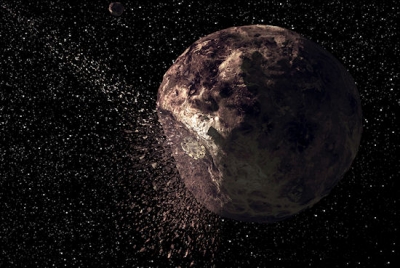
When we learn about the solar system, we are introduced to a class of objects called asteroids. Most of these asteroids exist in the main asteroid belt that lies between Mars and Jupiter. While this much is common knowledge these days, the existence of this asteroid belt wasn’t even known a little over 200 years back.
Pallas, third largest asteroid in the asteroid belt and the second such object to be discovered, by the German astronomer and physician Wilhelm Olbers on March 28, 1802, following the discovery of Ceres the year before. It is named after Pallas Athena, the Greek goddess of wisdom. A.s. Ganesh takes a look at the third largest asteroid in the asteroid belt……..
Late in the 18th Century, German astronomers Johann Daniel Titius and Johann Elert Bode arrived at a mathematical expression now known as Titius-Bode law. These calculations not only predicted the positions of the planets then known, but also suggested possible positions of others.
The search begins
When the discovery of Uranus in 1781 corresponded to that predicted by this law, there was a sense of anticipation as the law suggested another between Mars and Jupiter. Among the group of astronomers hunting down the missing planet was Wilhelm Olbers, a German physician who did his astronomical work by setting up his own house for the purpose.
Ceres, which was discovered by Italian astronomer Giuseppe Piazzi in January 1801, was believed to be the missing planet and was tracked down for a while before it went behind the sun. It was Carl Friedrich Gauss, a young mathematician who later became a good friend of Olbers, who devised a way to find out the orbit of an object using limited observations.
Olbers applied Gauss’ method and observed Ceres later in 1801. He continued this exercise on an everyday basis and discovered a similar object on March 28, 1802. Named after the Greek goddess of wisdom Pallas Athena, 2 Pallas (number based on order of discovery) can even be considered the first asteroid to be discovered as 1 Ceres was classified as a dwarf planet in 2006.
Remnants of a planet?
Apart from being the second such object to be discovered in what we now know as the asteroid belt, Pallas is also the third largest asteroid in the region. The discovery of Ceres and Pallas, along with Juno and Vesta over the next few years, led to the idea that asteroids are remnants of an actual planet. Even though this is no longer accepted, the idea that asteroids are pieces of the missing planet predicted by the Titius-Bode law endured for a long time.
While little was known about Pallas for over 200 years, a study in the past few years revealed that this asteroid has a violent, cratered past. In order to analyse Pallas’ shape and surface in detail, scientists used the Spectro-Polarimetric High-contrast Exoplanet Research (SPHERE) imager on the Very Large Telescope in the Atacama Desert of northern Chile.
Pockmarked surface
Researchers were able to capture 11 images of the asteroid’s surface. Using these images along with their own simulations, the scientists were able to tell that there were numerous craters ranging from 30 to 120 km wide on Pallas surface and that its appearance could even resemble that of a golf ball.
Even though the orbital eccentricity of Pallas is moderate, its orbital inclination is unusually large. This means that Pallas’ orbit is highly inclined with respect to the plane of the asteroid belt and the asteroid is therefore rather inaccessible to spacecraft. Plenty still remains unknown about this asteroid and even though missions are planned, Pallas is for now the largest asteroid that hasn’t been visited by a spacecraft yet.
Picture Credit : Google




